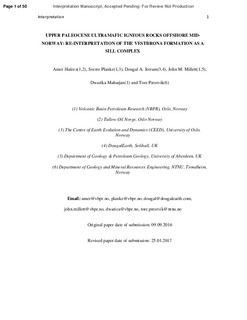| dc.contributor.author | Hafeez, Amer | |
| dc.contributor.author | Planke, Sverre | |
| dc.contributor.author | Jerram, Dougal Alexander | |
| dc.contributor.author | Millett, John M | |
| dc.contributor.author | Maharjan, Dwarika | |
| dc.contributor.author | Prestvik, Tore | |
| dc.date.accessioned | 2018-02-28T14:09:27Z | |
| dc.date.available | 2018-02-28T14:09:27Z | |
| dc.date.created | 2017-08-09T09:36:12Z | |
| dc.date.issued | 2017 | |
| dc.identifier.citation | Interpretation. 2017, 5 (3), SK103-SK120. | nb_NO |
| dc.identifier.issn | 2324-8858 | |
| dc.identifier.uri | http://hdl.handle.net/11250/2487810 | |
| dc.description.abstract | Continental breakup between NW Europe and Greenland (~56 Ma) ago was associated with widespread magmatism. Silica undersaturated alkaline porphyritic igneous rocks of a similar age have previously been dredged near the mid-Norwegian coast. These igneous rocks of the Vestbrona Formation have previously been interpreted as either igneous plugs or volcanic flows. New 3D seismic data show that relatively small sill complexes are abundant in the same region. In total, 36 sills with a size of 0.1 to 9 km2 have been mapped. In addition, ten seismic horizons were interpreted and tied to nearby wells to obtain a robust stratigraphic framework. The sills mainly intrude Cretaceous and Paleocene sequences, however, one sill is also identified in the pre-Cretaceous sequences. The sills locally form erosional remnants on the seabed due to massive uplifting and erosion of the continental margin. Vintage igneous and sedimentary dredge samples have been re-analyzed, including petrography, geochemistry (XRF, XRD), biostratigraphy, and Ar-Ar geochronology. The new Ar-Ar data suggest that the sills are 1-2 Ma older than breakup (ca. 57-58 Ma). Furthermore, the biostratigraphy and petrography of two sediment samples suggest that the samples were collected from near in-situ subcrops and not of an ice rafted origin. The sediment samples are of Danian age, and are strongly metamorphosed, most likely by contact metamorphism resulting from heating during sill emplacement. The newly identified sills have implications for the petroleum prospectivity of the study area including source rock maturation within thermal aureoles and the long term alteration of fluid migration pathways. | nb_NO |
| dc.language.iso | eng | nb_NO |
| dc.publisher | Society of Exploration Geophysicists | nb_NO |
| dc.title | Upper paleocene ultramafic igneous rocks offshore mid-Norway: Re-interpretation of the vestbrona formation as a sill complex | nb_NO |
| dc.type | Journal article | nb_NO |
| dc.type | Peer reviewed | nb_NO |
| dc.description.version | acceptedVersion | nb_NO |
| dc.source.pagenumber | SK103-SK120 | nb_NO |
| dc.source.volume | 5 | nb_NO |
| dc.source.journal | Interpretation | nb_NO |
| dc.source.issue | 3 | nb_NO |
| dc.identifier.doi | 10.1190/int-2016-0143.1 | |
| dc.identifier.cristin | 1485061 | |
| dc.relation.project | Norges forskningsråd: 223272 | nb_NO |
| dc.description.localcode | © 2017. This is the authors' accepted and refereed manuscript to the article. The final authenticated version is available online at: https://library.seg.org/doi/10.1190/INT-2016-0143.1 | nb_NO |
| cristin.unitcode | 194,64,90,0 | |
| cristin.unitname | Institutt for geovitenskap og petroleum | |
| cristin.ispublished | true | |
| cristin.fulltext | postprint | |
| cristin.qualitycode | 1 | |
